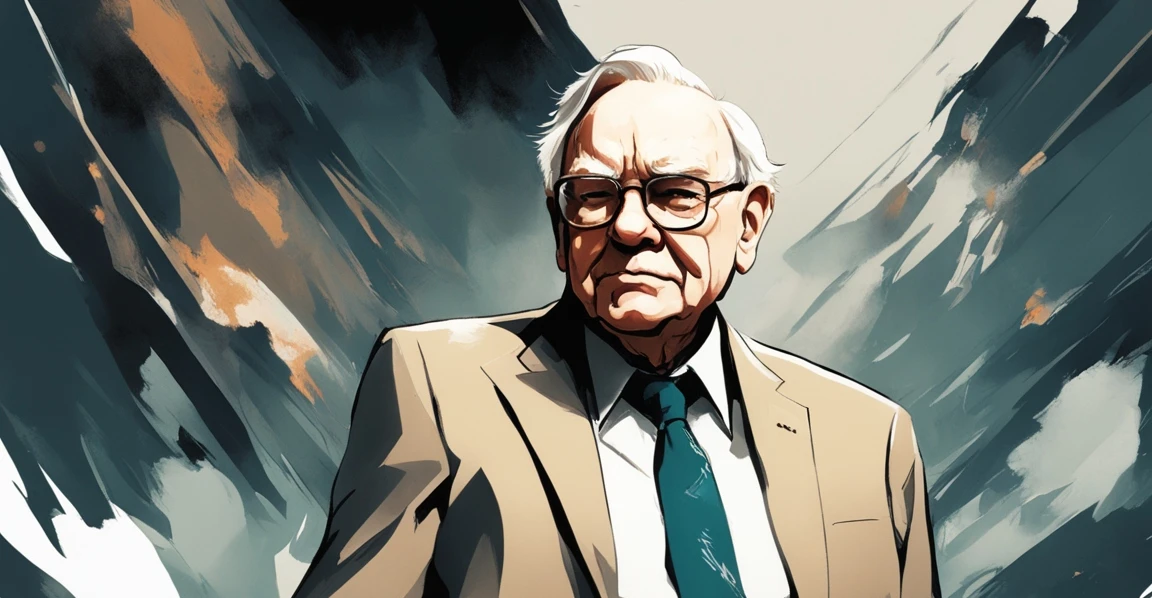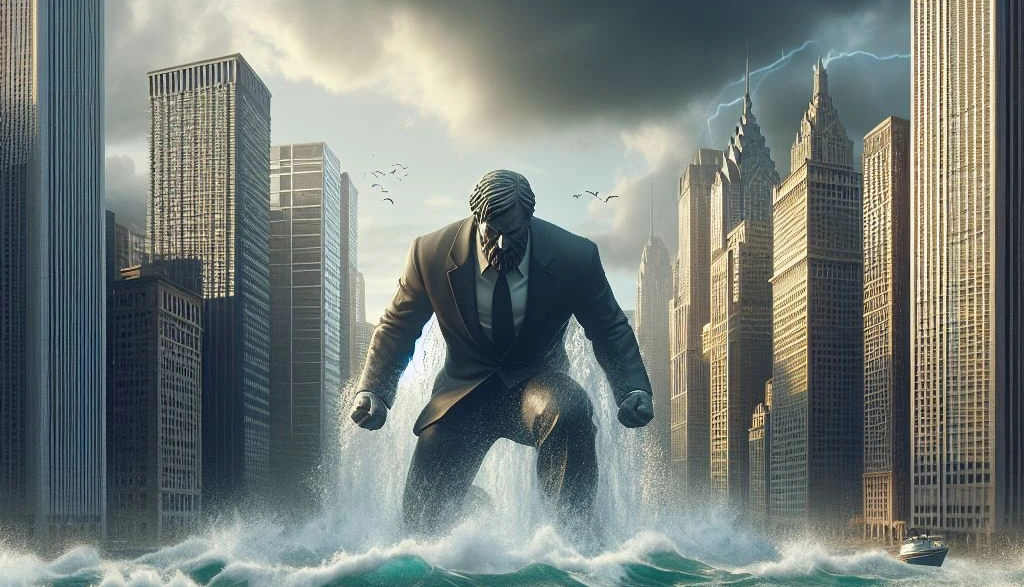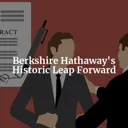Tags: Risk / History
This fanpage is not officially affiliated with Berkshire Hathaway: Disclaimer
Discover how Berkshire Hathaway, under Warren Buffett's leadership, has weathered catastrophic hurricanes like Katrina and Harvey, showcasing financial resilience and strategic foresight. Learn about the company's financial fortress, disciplined risk management, and readiness for future challenges in the volatile insurance industry. Shareholders, buckle up for an insightful journey through history's storms!

Introduction
In the ever-volatile world of insurance, hurricanes stand as towering giants of destruction, challenging the industry's resilience and adaptability. Among the titans of this industry, Berkshire Hathaway emerges as a formidable entity, not just surviving but thriving amidst the tempests wrought by nature's fury. At the helm, Warren Buffett, with his sagacious perspective on insurance risks, underscores the inevitability of "The Big One" — a catastrophic event that looms on the horizon, its form unknown yet its impact certain to be colossal. In his words from the 2023 annual report, Buffett warns of a disaster that "will dwarf hurricanes Katrina and Ian," highlighting the unpredictable nature of such calamities and their profound implications for insurers 1 11.
The historical significance of Hurricane Katrina in 2005 serves as a stark benchmark for catastrophic events, reshaping the landscape of insurance policies and industry standards. Berkshire Hathaway's encounter with Katrina resulted in a staggering $3.4 billion loss, a testament to the hurricane's devastating power and the financial resilience of Buffett's empire 4 ↗. This event, alongside the comparison with Hurricane Harvey in 2017, marks a pivotal moment in understanding the dynamics of catastrophic insurance and the strategic maneuvering required to withstand such blows.
This article aims to delve into the financial and operational resilience of Berkshire Hathaway amidst the catastrophic hurricanes that have marked the 21st century ↗↗. We will explore how the conglomerate has not only weathered these storms but also adapted and prepared for future cataclysms. The journey ahead will take us through the devastation of Hurricane Katrina, the comparative analysis with Hurricane Harvey, and into the fortified financial fortress that Berkshire Hathaway has built to face the inevitable challenges ahead.
The Devastation of Hurricane Katrina
Hurricane Katrina, striking in August 2005, stands as one of the most calamitous natural disasters in U.S. history. With a death toll updated to 1,392 and economic damages escalating to an unprecedented $190 billion, Katrina's fury was felt far beyond the immediate wind damage, ranking it among the most intense and costly tropical cyclones ever to make landfall in the contiguous United States 5. The hurricane's impact was magnified by engineering flaws in flood protection systems, leading to widespread flooding and a catastrophic failure of the levees surrounding New Orleans. The subsequent criticism of the government's emergency response highlighted the multifaceted nature of disaster management, where human error compounded natural ferocity.
The insurance industry faced its largest-ever windstorm loss, with over $41 billion in insured property damage and a total economic impact that may exceed $150 billion. This pivotal moment led to significant changes in insurance policy, with insurers revising property policies, tightening coverage wording, and revamping catastrophe (CAT) modeling to reduce loss estimates. The aftermath saw insurers requiring more robust disaster recovery procedures and employing technological advancements for improved claims processing 6 7.
Katrina also left an indelible mark on the Gulf Coast's demographic and economic landscape. Over one million people were displaced, creating the largest diaspora in U.S. history, and the region faced a daunting task of rebuilding and recovery. The insurance sector's response to future risks evolved, with some companies ceasing to insure homeowners in the area or raising premiums, reflecting the high costs associated with hurricanes Katrina and Rita. This shift underscored the industry's need to adapt to the realities of climate change and the increasing frequency of catastrophic events 5 8.
The National Hurricane Center (NHC) was commended for its accurate forecasts, which, despite the chaos, provided crucial information for emergency preparations. Yet, the long-term effects on insurance companies and policyholders alike have been profound, reshaping the industry's approach to catastrophic risk management and setting new standards for resilience and adaptability in the face of nature's most destructive forces.
However, as Buffett said in 2006 2: "It’s naïve to think of Katrina as anything close to a worst-case event."...

Berkshire Hathaway's Resilience
In the world of insurance, the name Berkshire Hathaway stands as a beacon of resilience and financial strength ↗. Under the astute leadership of Warren Buffett, Berkshire Hathaway has navigated the tumultuous waters of insurance risks with a philosophy that acknowledges the long-term nature and unpredictability of such perils. Buffett, in the company's 2023 annual report, candidly expressed the inherent challenges of assessing insurance risks, noting that mistakes can take years, even decades, to manifest fully. He ominously predicted that a major catastrophe, potentially far surpassing the likes of hurricanes Katrina and Ian, is inevitable, whether it emerges from traditional sources like wind or earthquakes, or unforeseen ones such as cyber attacks 1.
Berkshire Hathaway's unique stance in the insurance market is its willingness to assume more risk from a single event than any other insurer. This bold approach is underpinned by disciplined underwriting practices and an acute awareness of potential correlations in risk, ensuring that the company avoids writing policies that could result in pre-tax losses exceeding $15 billion from a single catastrophe event. This strategy not only demonstrates Berkshire Hathaway's unparalleled capacity to manage risk but also its commitment to financial prudence and shareholder value 1:
When properly paid for the risk assumed, we have been and will continue to be willing to assume more risk from a single event than any other insurer has knowingly assumed. Accordingly, we could incur a significant loss from a single catastrophe event resulting from a natural disaster or man-made catastrophes such as terrorism or cyber-attacks. We employ various disciplined underwriting practices intended to mitigate potential losses, attempt to take into account all possible correlations and avoid writing groups of policies from which pre-tax losses from a single catastrophe event might aggregate in excess of $15 billion.
The company's financial fortress is further evidenced by its operating earnings of $37.4 billion in 2023, excluding investment income, and a staggering shareholders’ equity of $561 billion ↗. Such figures not only underscore Berkshire Hathaway's ability to absorb significant losses but also its readiness to capitalize on opportunities in the aftermath of disasters 1.
Berkshire Hathaway's historical underwriting performance has been exemplary, with its first underwriting loss in 15 years occurring in 2017, a testament to its adept risk management practices. Despite this setback, the company's exposure to a hypothetical $400 billion megacatastrophe would result in losses estimated at $12 billion, a figure comfortably below its annual earnings from non-insurance activities. This financial resilience positions Berkshire as the insurer of choice for reinsurance coverages, cementing its status as the most secure insurance company for the foreseeable future 3.
Hurricane Katrina vs. Hurricane Harvey
The catastrophic impacts of Hurricanes Katrina and Harvey serve as stark reminders of the destructive power of nature and the pivotal role of insurance in recovery efforts. Hurricane Katrina, striking in August 2005, and Hurricane Harvey, hitting in August 2017, both left indelible marks on the United States through their devastating tolls on human life, economic losses, and the insurance industry.
Katrina, a Category 5 hurricane, led to 1,836 fatalities and damages estimated between $97.4 billion to $190 billion, making it one of the costliest tropical cyclones on record. The failure of the flood protection system around New Orleans, particularly the levees, resulted in widespread flooding and significant loss of life. The economic impact was profound, with the forestry industry alone suffering approximately $5 billion in losses, and over one million people displaced, marking the largest diaspora in US history 5.
In comparison, Hurricane Harvey, a Category 4 storm, caused over 100 deaths and $125 billion in damage, tying with Katrina as the costliest tropical cyclone on record. Harvey's record-breaking rainfall led to unprecedented flooding in Texas, with economic loss estimates ranging from $81 billion to $190 billion. The Insurance Council of Texas estimated insured losses from Harvey at $19 billion, highlighting the significant financial impact on the insurance industry 9.
The response of the insurance industry to these disasters has evolved significantly. Post-Katrina, the industry saw overhauls in property insurance, claims processing, and disaster recovery procedures, driven by the lessons learned from the storm's aftermath. Technological advancements have since improved claims technology, allowing for more efficient and effective responses to disasters 7.
Berkshire Hathaway, despite suffering a $1.4 billion insurance underwriting loss from Harvey and other events in 2017, showcased its financial resilience and preparedness for such catastrophes. The company's disciplined approach to underwriting and risk management, coupled with its substantial financial resources, enabled it to absorb the losses without jeopardizing its financial stability or its ability to take on new business 10.
The juxtaposition of Hurricanes Katrina and Harvey illustrates not only the increasing frequency and severity of such natural disasters but also the critical role of the insurance industry in mitigating their financial impacts. For Berkshire Hathaway, these events have tested and ultimately reinforced its reputation as a financial fortress, capable of weathering the storms of history and emerging stronger in their wake.

Berkshire's Financial Fortress
At the heart of Berkshire Hathaway's resilience in the face of financial storms is its financial fortress, a term that aptly describes the conglomerate's robust financial health and strategic underwriting practices. With an insurance float of $168.8 billion in 2023 1, Berkshire Hathaway stands as a colossus in the insurance industry, underpinned by shareholders’ equity of $561 billion 1. These figures are not just numbers but a testament to the company's ability to weather large-scale catastrophes and emerge stronger.
Operating earnings in 2023, excluding investment income, stood at $37.4 billion 1, showcasing Berkshire's ability to generate substantial profits through its diverse range of businesses ↗. This financial strength is critical, as it positions Berkshire to not only survive but thrive after large-scale catastrophes. The significance of Berkshire's disciplined underwriting practices cannot be overstated. As noted by Warren Buffett, the conglomerate is prepared to handle catastrophic losses with a low exposure ratio of 3% to large events, a confidence bolstered by its first underwriting loss in 15 years in 2017—a mere $3.2 billion pre-tax loss amid a challenging year for insurers 3.
Berkshire Hathaway's strategic importance of maintaining a large float benefits the company in times of crisis, acting as a "free" capital that Buffett can deploy into investments or use for acquisitions. This float acts as a critical buffer, allowing Berkshire to absorb losses far exceeding those of its competitors without jeopardizing its financial stability.
The conglomerate's approach to risk management sets it apart from and influences the broader insurance industry. By assuming more risk from a single event than any other insurer has knowingly assumed, Berkshire demonstrates a unique blend of courage and caution. This disciplined approach, coupled with the conglomerate's unparalleled financial strength, positions Berkshire Hathaway as the most secure insurance company for decades to come 3.
The Future of Insurance in the Face of Catastrophes
The future of insurance, particularly in the face of catastrophes, is on a trajectory marked by evolving risks and emerging threats. Warren Buffett himself has warned of "The Big One"—a major catastrophe that could come from traditional sources like wind or earthquake, or unexpected ones such as a cyber-attack, with potentially disastrous consequences beyond anything insurers now contemplate 1. This looming threat underscores the need for the insurance industry to continuously improve risk modeling, policy wording, and property risk engineering.
Post-Katrina, the insurance industry learned valuable lessons, leading to significant improvements in response to disasters. Changes in property insurance, claims, analytics, and crisis management have been outlined, highlighting a shift towards more accurate CAT modeling and tightened wording of property policies 7. These adjustments, alongside a renewed focus on property risk engineering and disaster recovery procedures, represent the industry's efforts to adapt to the changing landscape of risks.
The potential impact of climate change on the frequency and severity of hurricanes and other natural disasters poses an additional layer of complexity. As such, Berkshire Hathaway and the insurance industry at large are bracing for these future challenges by enhancing their disaster response capabilities and claims processing through technology. The use of technological advancements has fundamentally improved since Katrina, offering insurers and policyholders better tools for managing catastrophic losses 7.
Looking ahead, insurance policies and coverage options are likely to evolve to accommodate the increasing risk of mega-catastrophes. This evolution will necessitate a delicate balance between providing comprehensive coverage and maintaining the financial viability of insurance providers. With its financial fortress and disciplined approach to risk management, Berkshire Hathaway is well-positioned to lead the industry through these uncertain times, offering a blueprint for how insurers can prepare for and respond to the catastrophes of the future.
Berkshire Hathaway's financial strength and strategic foresight have cemented its status as a beacon of stability in the tumultuous insurance industry. As the company and the broader industry navigate the evolving landscape of risks, the lessons learned from past events, coupled with technological advancements and improved risk management practices, will be instrumental in shaping the future of insurance in the face of catastrophes.

Conclusion
Berkshire Hathaway's journey through the storms of history showcases a remarkable tale of resilience, adaptability, and strategic foresight in the face of catastrophic events. The conglomerate, under the visionary leadership of Warren Buffett, has not only weathered the tempests of Hurricane Katrina and Harvey but has emerged stronger, fortified by a financial fortress and disciplined risk management practices.
The devastation wrought by Hurricane Katrina served as a pivotal moment in the insurance industry, reshaping policies, claims processing, and disaster response procedures. Berkshire Hathaway's response to these challenges highlighted its unique position as a beacon of stability in a volatile industry. The company's financial strength, operational resilience, and strategic underwriting practices set it apart as a leader in the face of catastrophic risks.
The comparison between Hurricanes Katrina and Harvey underscores the evolving nature of risks and the increasing frequency of mega-catastrophes. Berkshire Hathaway's ability to absorb losses exceeding those of its competitors, while maintaining financial stability and shareholder value, positions it as the insurer of choice for reinsurance coverages in the years to come.
Looking ahead, the future of insurance in the face of catastrophes will require continuous innovation, improved risk modeling, and enhanced disaster response capabilities. Berkshire Hathaway's readiness to face "The Big One" and its commitment to financial prudence offer a blueprint for the industry to navigate the uncertainties of climate change and emerging threats.
As shareholders of Berkshire Hathaway, we can take pride in the company's track record of resilience and preparedness, knowing that our investments are in safe hands. The lessons learned from past events, the insights of Warren Buffett, and the ongoing evolution of insurance practices will guide us through the challenges of the future, ensuring stability and security in an uncertain world.
Let us continue to learn, adapt, and prepare for the storms ahead, knowing that Berkshire Hathaway stands as a steadfast fortress in the face of history's trials. Together, we can weather any storm and emerge stronger on the other side.
References
-
2006 Annual Report - www.berkshirehathaway.com ↩
-
Why Hurricanes Don't Worry Warren Buffett | The Motley Fool - www.fool.com ↩↩↩
-
Berkshire Hathaway's profit up nearly fivefold - www.nbcnews.com ↩
-
Hurricane Katrina - Wikipedia - en.wikipedia.org ↩↩↩
-
Lessons learned from Hurricane Katrina - commercial.allianz.com ↩
-
How insurance policies have changed in the post-Katrina years - www.cbsnews.com ↩↩↩↩
-
hubinsurancehunter.ca - www.hubinsurancehunter.ca ↩
-
Hurricane Harvey - Wikipedia - en.wikipedia.org ↩
-
Insurance loss from disasters cuts profits at Buffett's firm - financialpost.com ↩
-
The complete quote from Buffett's 2023 annual letter to shareholders reads as1: "Mistakes in assessing insurance risks can be huge and can take many years – even decades – to surface and ripen. (Think asbestos.) A major catastrophe that will dwarf hurricanes Katrina and Ian will occur – perhaps tomorrow, perhaps many decades from now. “The Big One” may come from a traditional source, such as wind or earthquake, or it may be a total surprise involving, say, a cyber attack having disastrous consequences beyond anything insurers now contemplate. When such a mega-catastrophe strikes, Berkshire will get its share of the losses and they will be big – very big. Unlike many other insurers, however, handling the loss will not come close to straining our resources, and we will be eager to add to our business the next day." ↩












